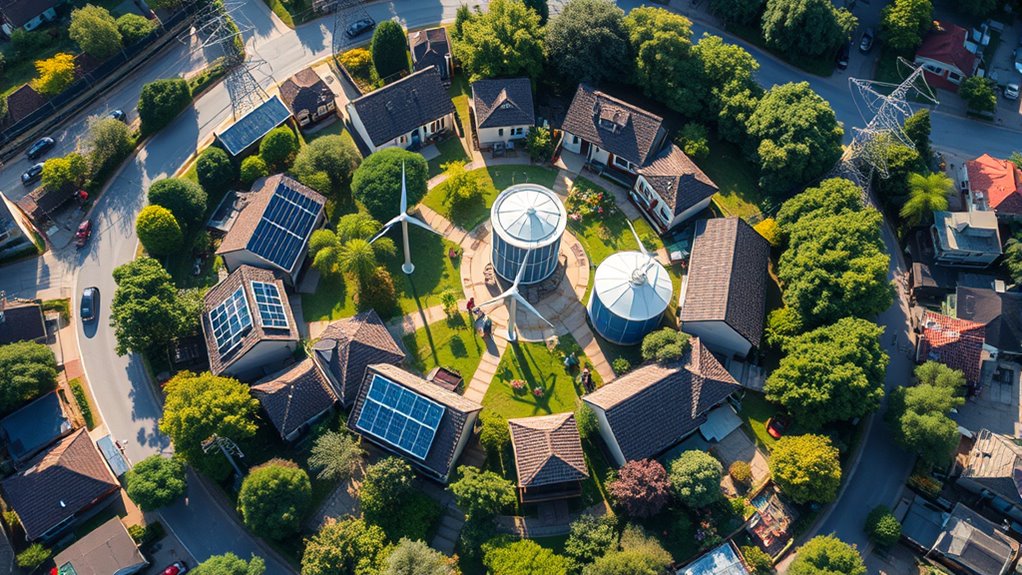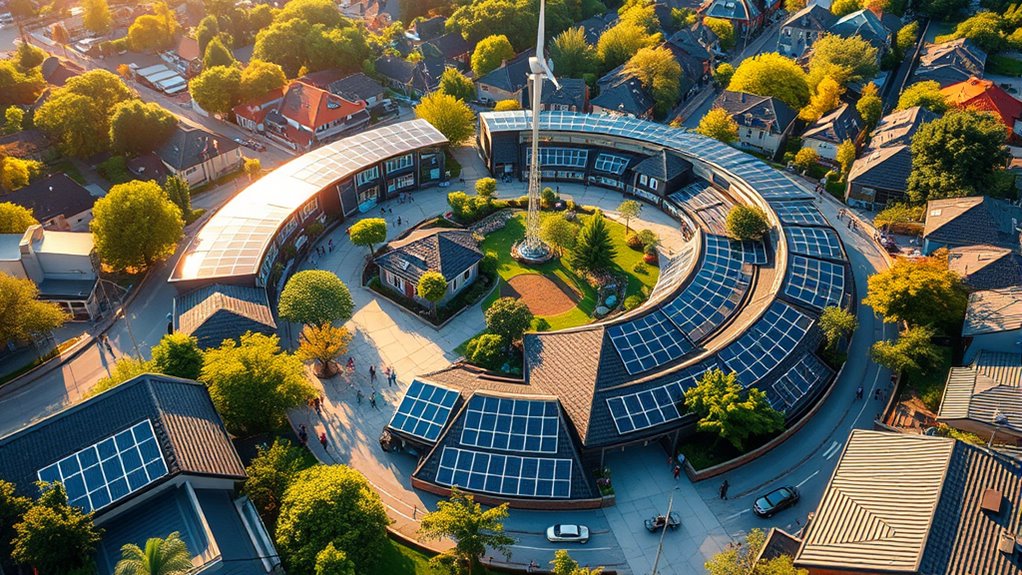Circular microgrids let neighborhoods generate, share, and profit from renewable energy like solar and wind. You can produce your own power, store excess for later use, and sell surplus energy within the community. This approach boosts local resilience, reduces energy costs, and promotes sustainability. Plus, it gives residents a chance to contribute to environmental goals while gaining economic benefits. If you’re curious about how these systems work and their advantages, there’s much more to explore below.
Key Takeaways
- Circular microgrids enable neighborhoods to generate, share, and store renewable energy locally, increasing energy independence.
- Excess power can be sold back to the grid, creating revenue streams for residents and promoting economic sustainability.
- Integration of solar, wind, and hydro sources ensures a resilient, flexible energy supply tailored to community needs.
- Power sharing within microgrids optimizes resource use, reduces reliance on centralized power plants, and enhances system resilience.
- Modular design allows microgrids to scale with community growth, supporting long-term profitability and environmental goals.

Have you ever wondered how communities can generate and manage their energy more sustainably? Circular microgrids are transforming neighborhoods into self-sufficient energy hubs, allowing residents to produce, share, and profit from their power. The core idea revolves around power sharing within a localized network, which fosters a resilient and efficient energy system.
Instead of relying solely on centralized power plants, these microgrids integrate renewable sources like solar panels, wind turbines, and small-scale hydro, guaranteeing a cleaner and more sustainable energy supply. By doing so, communities reduce their dependence on traditional grids and lower their carbon footprint, all while gaining more control over their energy resources.
One of the most compelling aspects of circular microgrids is how they enable renewable integration. You can install solar panels on rooftops or set up community wind turbines, creating a decentralized energy source that feeds directly into the microgrid. This setup allows neighborhoods to generate their own power, which can be used locally or stored for later use. Excess energy doesn’t go to waste; instead, it can be shared among residents through power sharing arrangements.
This not only optimizes energy use but also encourages a sense of cooperation and collective responsibility within the community. With power sharing, residents benefit from a more stable and resilient energy system. During peak sunlight hours, solar panels produce more energy than needed, and this surplus can be redistributed to households or businesses that need it. Conversely, when renewable sources aren’t producing enough, stored energy from batteries can fill the gap.
This dynamic exchange minimizes outages and enhances reliability, especially during extreme weather or grid failures. Additionally, by participating in local energy markets, residents can sell excess power, turning their microgrids into income generators. This creates a cycle where energy becomes a shared resource and a revenue stream, promoting economic sustainability alongside environmental benefits.
Furthermore, the modular nature of circular microgrids makes them adaptable to different community sizes and needs. You can start small, with a handful of homes, and expand as technology advances or community interest grows. The integration of renewable energy sources and power sharing mechanisms ensures that these microgrids remain flexible and efficient. Proper tuning and maintenance of the systems are essential to maximize performance and longevity.
Frequently Asked Questions
How Do Circular Microgrids Impact Local Economies Long-Term?
You might wonder how microgrids affect local economies long-term. They boost energy independence, reducing reliance on external power sources and lowering costs. This creates opportunities for local employment in installation, maintenance, and management of the systems.
Over time, communities can generate profits from excess energy, reinvesting in local projects. Ultimately, microgrids strengthen economic resilience, foster innovation, and promote sustainable growth within neighborhoods.
What Are the Main Challenges in Implementing Circular Microgrids?
You face challenges like technical barriers, which include integrating new technologies and maintaining grid stability.
Community engagement is also a challenge, as convincing residents to adopt and support microgrids can be tough.
Overcoming these hurdles requires clear communication, education, and technical expertise.
How Do Microgrids Coordinate With Existing Power Grids?
You coordinate microgrids with existing power grids through grid synchronization, ensuring your microgrid’s voltage and frequency match the main grid. This allows seamless energy flow, especially during peak times or outages.
You can also engage in energy trading, selling excess power or buying when needed, which optimizes efficiency and profits.
Proper communication and control systems are essential for smooth integration and maintaining grid stability.
What Is the Initial Investment Required for a Neighborhood Microgrid?
You’ll need to take into account the cost estimation for setting up a neighborhood microgrid, which varies based on size, technology, and infrastructure.
Initial investments can range from hundreds of thousands to several million dollars.
Funding sources like government grants, private investors, or community funds often help cover these costs.
Planning carefully and exploring diverse funding options will ensure you can start your microgrid project effectively and sustainably.
How Do Regulatory Policies Influence Microgrid Adoption?
Think of regulatory policies as the traffic signals guiding microgrid adoption. When policies have too many barriers, they slow down progress, making it tough to navigate.
But policy incentives act like green lights, encouraging neighborhoods to embrace microgrids. You’ll find that supportive regulations accelerate deployment, while restrictive ones can hinder growth.
Ultimately, clear, balanced policies are key to turning microgrid dreams into reality, powering communities more sustainably.
Conclusion
Imagine neighborhoods gently weaving their own tapestry of power, each home a vibrant thread contributing to a seamless, self-sustaining fabric. Circular microgrids quietly turn the wheels of progress, offering a harmonious dance of energy and profit. As you step into this future, you’ll see communities blooming with independence, where every spark of innovation sparks collective prosperity. Embrace this gentle revolution, and watch neighborhoods flourish in a dance of sustainable abundance.










